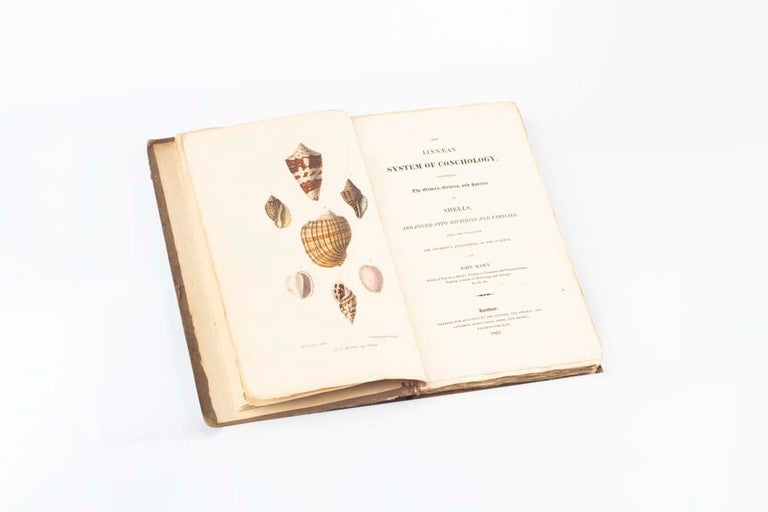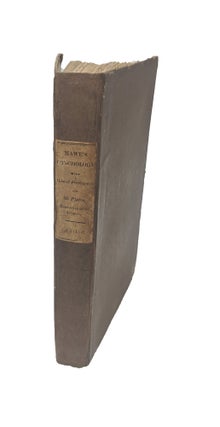The Linnæan System of Conchology…
The Linnæan System of Conchology, describing the Orders, Genera, and Species of Shells, arranged into Divisions and Families: with a view to facilitate the student's attainment of the science.
London: printed for and sold by the author… and Longman, Hurst, Rees, Orme, and Brown, 1823.
Octavo, with 37 lithograph plates, the first of which is the handcoloured frontispiece; a fine and large copy, completely uncut in the original binding of brown boards with printed label; 16 pp Longmans advertisements dated April 1826 at start and 2 pp Mawe's own advertisements at the end.
The shells of the world, classified as per Linnaeus
A fundamental and very well illustrated classification of shells of the world by one of the leading 19th-century shell experts, a major authority on the subject. Dedicated to the President and Fellows of the Linnæan [now Linnean] Society, the body founded by Sir James Edward Smith in 1788, Mawe's book encompasses the shells of the world, many of them discoveries of the previous few decades by explorers and travellers. Mawe had been an acquirer of shells for many years, his most significant purchase having been the entire collection of William Bligh's widow Elizabeth, "for a valuable consideration", which he had offered at auction in the year preceding this publication, noting in the preface to the catalogue that "…To any voyager fond of this beautiful branch of Natural History, or to any collector resident on their shores, the South Seas offer a fine harvest; but the late Admiral Bligh had, from the situations in which his professional eminence placed him, the best opportunities of procuring whatever was most valuable and rare, from a field proverbially rich". Mawe himself both studied and acquired from those same rich fields, his geographical sources cited in the present work ranging all over the world and including New Holland, New South Wales, New Zealand, the South Seas and other parts of the "new" world.
A fundamental and very well illustrated classification of shells of the world by one of the leading 19th-century shell experts, a major authority on the subject. Dedicated to the President and Fellows of the Linnæan [now Linnean] Society, the body founded by Sir James Edward Smith in 1788, Mawe's book encompasses the shells of the world, many of them discoveries of the previous few decades by explorers and travellers. Mawe had been an acquirer of shells for many years, his most significant purchase having been the entire collection of William Bligh's widow Elizabeth, "for a valuable consideration", which he had offered at auction in the year preceding this publication, noting in the preface to the catalogue that "…To any voyager fond of this beautiful branch of Natural History, or to any collector resident on their shores, the South Seas offer a fine harvest; but the late Admiral Bligh had, from the situations in which his professional eminence placed him, the best opportunities of procuring whatever was most valuable and rare, from a field proverbially rich". Mawe himself both studied and acquired from those same rich fields, his geographical sources cited in the present work ranging all over the world and including New Holland, New South Wales, New Zealand, the South Seas and other parts of the "new" world.
Traveller, collector and conchologist, he also ran a flourishing business at 149 Strand. His advertisement that ends the book shows that as well as his own several publications he held a wide stock of minerals and associated apparatus, and of course shells. He offered "an extensive variety of the finest specimens" with "collections of shells for students, showing the Genera, at various prices from Three Guineas to Twenty". Offered too were "secondary shells, a great variety" and finally the tempting "Inferior Shells for Grottoes".
The beautifully drawn lithographic plates that illustrate the book were by E.A. Crouch: most authors fail to acknowledge their illustrators but Mawe flags in his Preface (p xii) that 'The plates which embellish this work are taken from specimens in our own cabinet, and we are indebted to the kindness and indefatigable exertions of an artist of the greatest talent, for the accurate and elegant delineation of them'.
Mawe was an influential figure of his period. Briefly at one time a captain in the merchant marine, he became one of the loose grouping of individuals who cherished and competed for the finds made by the explorers.
Provenance: Mary Walker (ink signature on endpaper).
Not known to Ferguson despite Australian content (an earlier work is listed as 397).
Condition Report: Joints neatly repaired.
Price (AUD): $2,850.00
US$1,837.09 Other currencies



